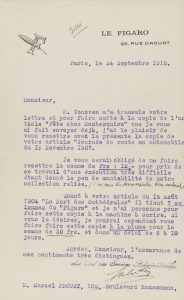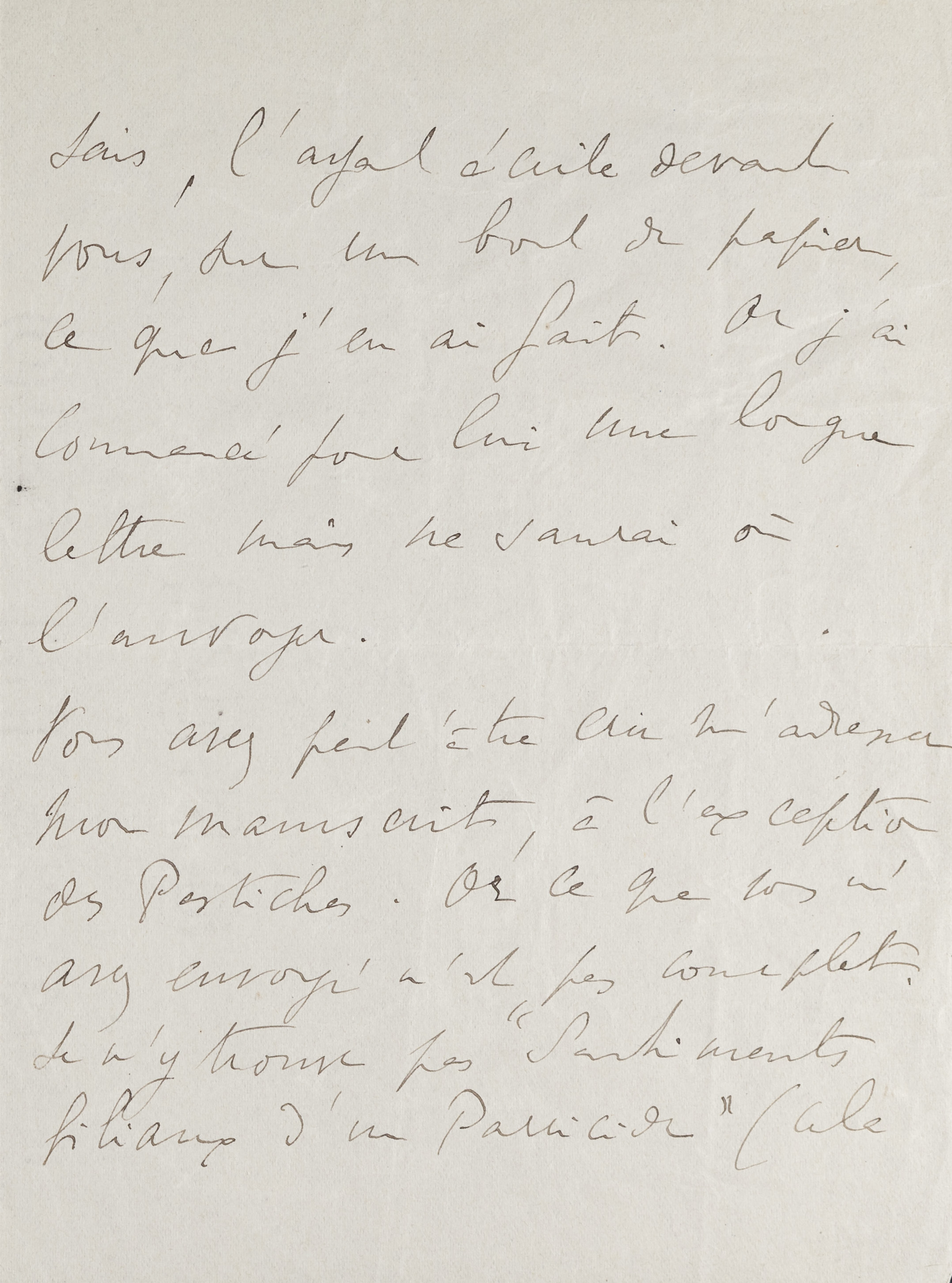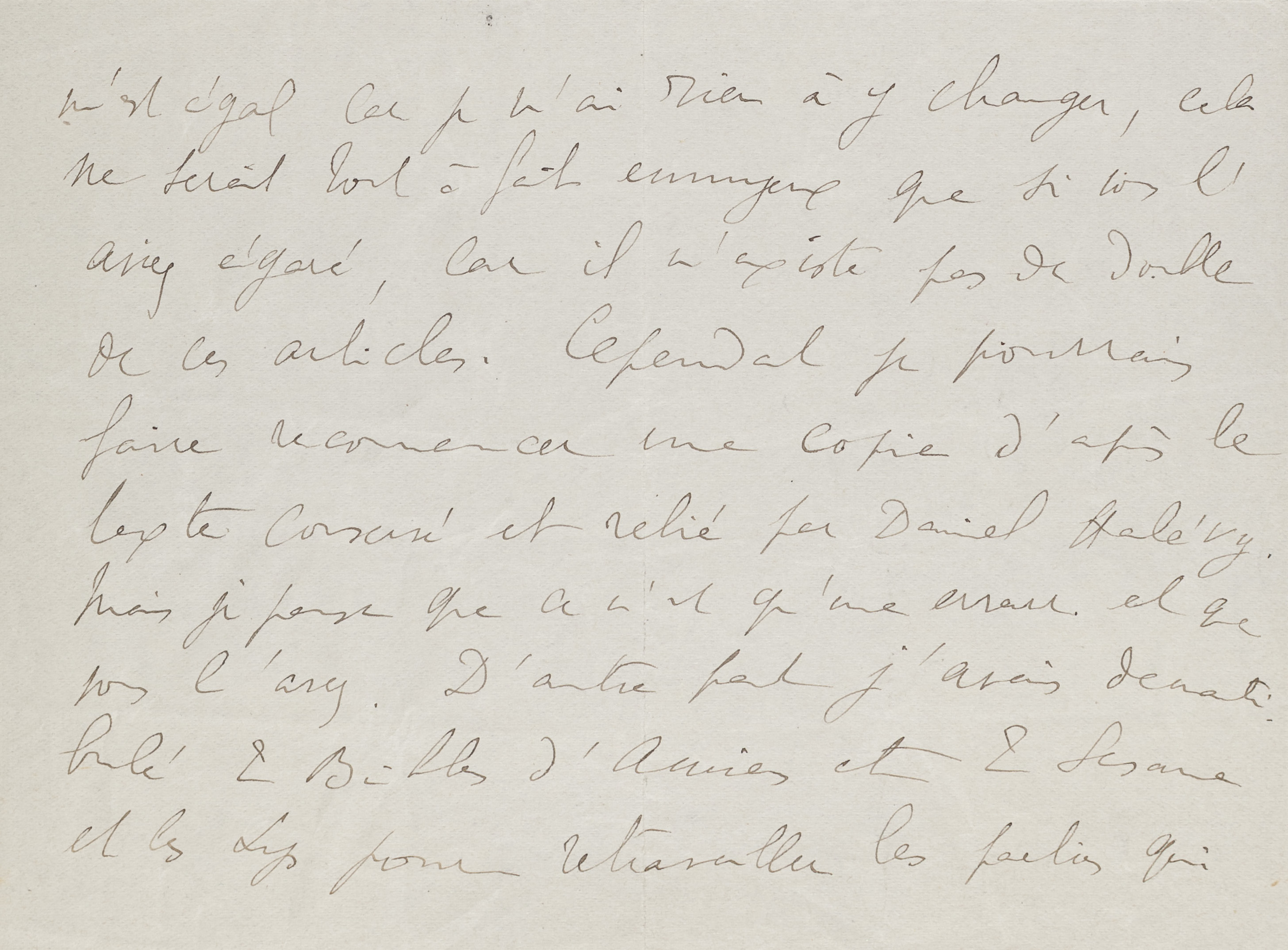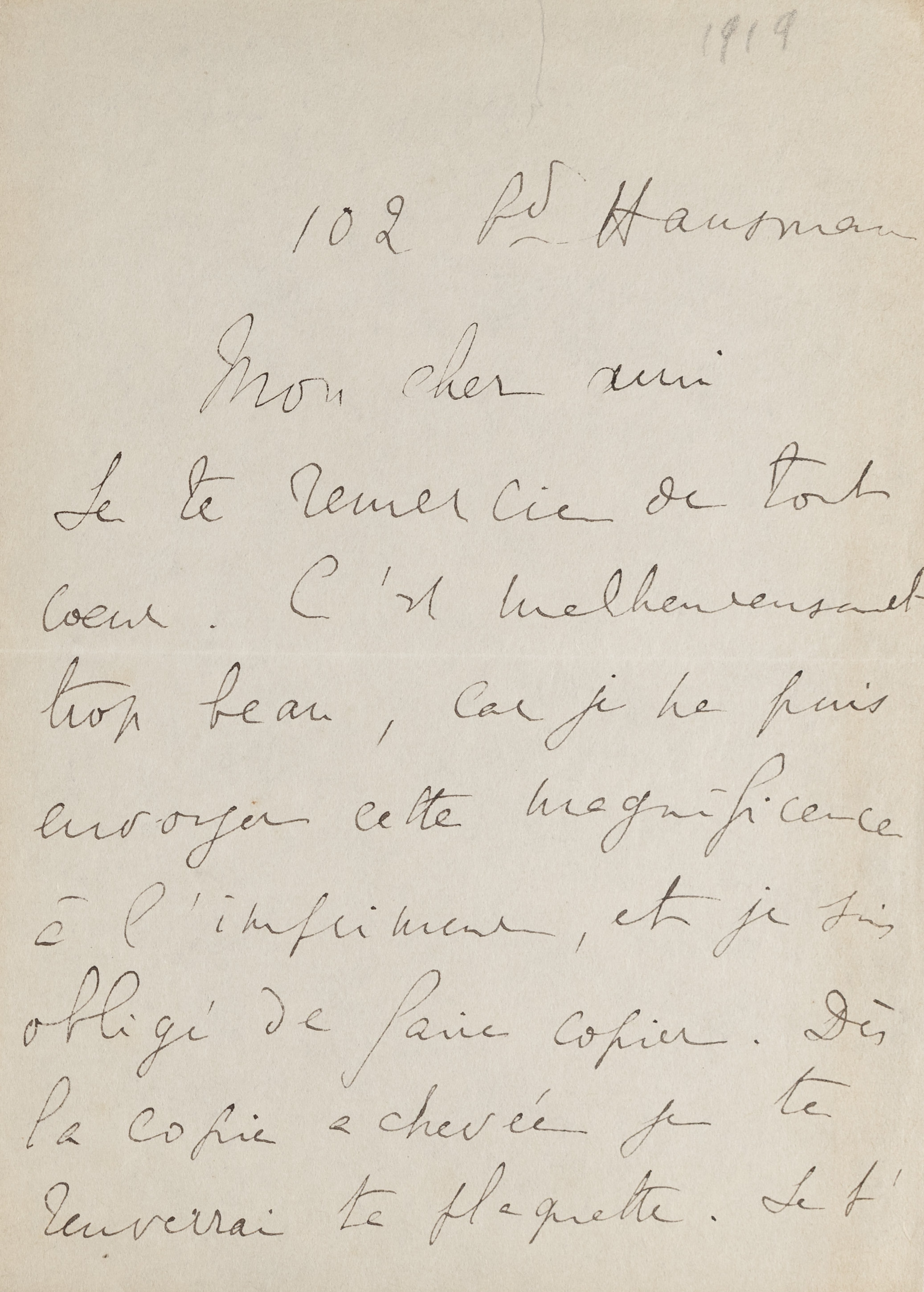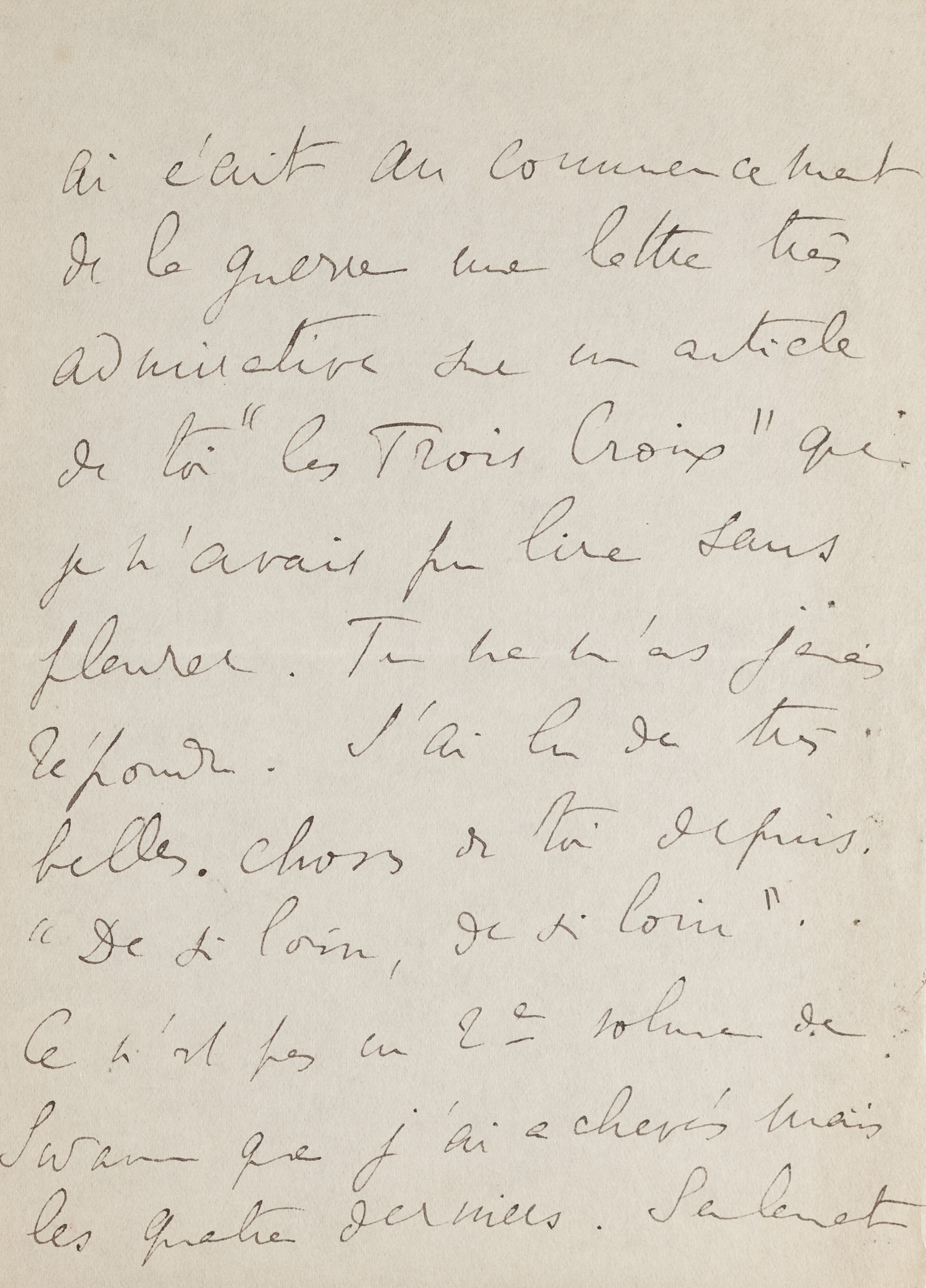by Mouna Benbouazza, graduate student in French
Letter from Le Figaro to Marcel Proust, 24 September 1918 [1]
LE FIGARO
26, rue Drouot [2]
Paris, 24 September 1918
Sir,
Mr. Vonoven [3] forwarded me your letter, and to follow up on the copy of the article “Fête chez Montesquiou” which I have already sent you, I am pleased to send you with with this letter a copy of your article “Journée de route en automobile” [4] from 19 November 1907.
I would be grateful if you could have the sum of 12 Fr sent to me for the price of this labor, quite difficult to execute since our bound collection is not easy to handle. (This is for the two articles, of course[.])
Regarding your article of 16 August 1904, “La Mort des Cathédrales,” it takes up 7 columns of the “Figaro,” and I do not have anyone available to copy it at the typewriter. If you wish, however, I could do a handwritten copy for the sum of 30 Fr, within 8 to 10 days.
Accept, Sir, the assurances of my highest consideration.
The Chief of Administrative Services
Jules Levy [5]
Mr. Marcel PROUST, 102, Boulevard Haussmann
[1] Letter catalogued as Proust-Series 1 / Lefebvre 105, Rare Book and Manuscript Library, University of Illinois at Urbana-Champaign.
[2] Before moving to the Champs-Elysées in 1929, Le Figaro had its headquarters on rue Drouot, in the 9th arrondissement of Paris.
[3] (Note by P. Kolb) Henri Vonoven was the secretary general of Le Figaro.
[4] (Note by P. Kolb) “Impressions de route en automobile” is an article that will be republished in the Pastiches et Mélanges. Here the writer of the letter wrongly refers to the article as “Journée de route en automobile.”
[5] P. Kolb identified the signature as “Jules Ley” or “Jules Levy.”
This letter from 24 September 1918, typewritten by the chief of administrative services of Le Figaro, references three articles published there between 1900 and 1907. Proust, who also published in literary magazines when he was younger, was an occasional contributor to the prestigious newspaper before he started work on his novel. In 1904 Le Figaro published “La mort des cathédrales,” [The Death of Cathedrals], a piece where Proust vehemently criticizes the French government’s project to deprive cathedrals of their religious use, transforming the buildings into museums, for example, in the context of the movement towards church and state separation. For Proust, who regarded cathedrals as pillars of French memory, this move represented an attack on history. The 1907 article “Impressions de route en automobile” [Impressions of the road from an automobile] described the sights and sensations that Proust experienced during a road trip with his driver and companion Alfred Agostinelli. Proust also wrote articles where he satirized the social circles he frequented. “Fête chez Montesquiou,” for exemple, portrays his extravagant friend Robert de Montesquiou. Excerpts from his translation of John Ruskin’s The Bible of Amiens also appeared in Le Figaro in 1900.
In September and October 1918, Proust was working on assembling various articles that had appeared in Le Figaro for a collection titled Pastiches et Mélanges to be printed by his new publisher, the Nouvelle Revue française, a process that turned out to be long and difficult. Proust, who did not keep personal records of his articles, requested that the newspaper have some of his articles copied from their archives, and sent to him, among them “La mort des cathédrales.” Here, the author of the letter underlines that the article “takes up 7 columns of Le Figaro” and that he “could do a handwritten copy for the sum of 30 francs” [6] to emphasize the difficulty of the work. The letter exemplifies the administrative difficulties that often accompanied Proust’s editorial relationships.
The header bears the logo of Le Figaro (at the top left of the page), the letter “F” crossed by a quill; notice also the stamp of the Chief of Administrative Services (bottom right), after the closing salutations and above the signature.
[6] Equivalent to approximately 42 euros or 52 U.S. dollars today.
Letter from Marcel Proust to Berthe Lemarié, [5(?) December 1918] [7]
Dear Madam, [8]
I would be pleased to know if you and your son, and your loved ones, as well as everyone at the Revue [9] escaped the flu. I would also like to know the address of Gaston Gallimard [10]. You did give it to me but I do not know, after having written it in front of you, on a piece of paper, what I have done with it. Now I have started a long letter to him but I do not know where to send it.
You may have thought you were sending me my manuscript, except for the Pastiches. Yet what you sent me is incomplete. I cannot find “Sentiments filiaux d’un parricide” [11] (it matters little because I do not wish to make any change to it; it would only be annoying if you had lost it, because there are no copies of these articles[)]. However I could have another copy made, based on the text collected and bound by Daniel Halévy. But I believe this is only a mistake and you must have it. Additionally, I had taken apart two Bibles d’Amiens and two Sésame et les Lys to rewrite the parts that will be published, so that my corrections were not front and back. However you sent me only one manuscript of each. I would then have to write on the backs. But I found another Bible and another Sésame from the bookshop. I will redo the pages. And I am only telling this to ask you to excuse a delay of a few days. Nothing has come from Le Côté de Guermantes yet. Please accept, dear Madam, my profound, respectful and grateful affection.
Marcel Proust
[7] Letter catalogued as Proust-Series 1 / Lefebvre 007, Rare Book and Manuscript Library, University of Illinois at Urbana-Champaign.
[8] P. Kolb dates this letter from “a few days before 8 December, 1918, likely 5 December 1918” (Corr, vol. XVII, p. 494).
[9] The Nouvelle Revue française was a literary periodical founded in 1909.
[10] (Note by P. Kolb) Proust was looking for Gaston Gallimard’s address in New York, where he was traveling at the time.
[11] “Filial Sentiments of a Parricide.” For this 1907 article, Proust was inspired by the murder of Madame van Blarenberghe, a friend of his family, by her son Henri. The article was requested by the director of Le Figaro, Gaston Calmette.
This letter is part of a sustained correspondence between Proust and Berthe Lemarié, a secretary at the Nouvelle Revue française and the assistant of Gaston Gallimard. From 1911, Gallimard directed the Revue and launched an affiliated publishing house, initially named after the Revue and later named after him. In 1916, Proust left his previous publisher Grasset for Gallimard. By the end of 1918, Proust was working on assembling his Figaro articles for a collection to be titled Pastiches et Mélanges; at the same time, he was finishing Le Côté de Guermantes. Proust and the Nouvelle Revue française agreed to publish Pastiches et Mélanges in 1919, to be printed at the same time as À l’ombre des jeunes filles en fleurs and a reedition of Du côté de chez Swann. Accordingly, Proust communicated regularly with Berthe Lemarié.
Proust’s impatience on the progress of these projects is apparent in this letter. He had sent his articles from Le Figaro and was waiting for proofs from the printer Gallimard had found, La Semeuse. Here, Proust explains that he “cannot find ‘Sentiments filiaux d’un parricide’” among the articles sent to him by Berthe Lemarié; he thinks that “this is only a mistake and you must have it.” Once again, we see that Proust did not keep archives of his articles.
In June 1918 [12], Proust had submitted the full manuscript of Le Côté de Guermantes, but in this letter he bemoans that “nothing has come from Le Coté de Guermantes yet.” Proust was regularly complaining to Gaston Gallimard, even as the latter was frequently traveling to New York, where he had joined a theatre company in its effort to promote French culture in the context of the First World War.
Overall, however, Proust and Berthe Lemarié maintained a polite, even warm, correspondence. In this letter, Proust hopes that “all the Revue has escaped the flu,” referring to the deadly influenza pandemic that struck Europe in 1918 and 1919. The epidemic, which killed tens of millions of people around the globe, as well as the recently ended war, are factors that surely exerted pressure on the printing work and contributed to delays.
[12] See Proust, letter to Gaston Gallimard, 7 November 1918 (Corr., vol. XVII, p. 441-442).
Letter from Marcel Proust to Daniel Halévy, [shortly after 5 December 1918] [13]
102 boulevard Haussmann [14]
My dear friend
My heartfelt thanks. Unfortunately it is too fine, since I cannot send this magnificent piece of work to the printer, and I must have it copied [15]. As soon as the copy is done, I will send you back your booklet [16]. I wrote you, at the beginning of the war, a letter [17] where I expressed my great admiration of your article “Les Trois Croix” [18], which I had been unable to read without crying. You never answered me. I have read many beautiful things of yours since then. “From so far away, from so far away” [19].
It is not a second volume of Swann I have finished but the last four volumes. I will initially only release the second, at the same time as the collection of pastiches and articles (if I can find them). It seems to me that you used to call me Marcel and I preferred that to Proust. But one should not ask for such things. Please especially thank Madame Halévy and give her all my respects.
Gratefully yours,
Marcel Proust
[13] Letter catalogued as Proust-Series 7 (Items by Proust) / Item Proust 75-002, Rare Book and Manuscript Library, University of Illinois at Urbana-Champaign.
[14] P. Kolb dates this letter from “shortly after 5 December 1918” (Corr, vol. XVII, p. 498-499).
[15] (Note by P. Kolb) The text in question is “Sentiments filiaux d’un Parricide.”
[16] This was not done: seven months later, in July 1919, Proust writes to Halévy that he still has the booklet “beside [his] bed.”
[17] Letter from Marcel Proust to Daniel Halévy, evening of 16 November 1914 (Corr., vol. XIII, p. 331).
[18] Daniel Halévy, “Les Trois Croix,” [The Three Crosses], Journal des Débats, 17 November 1914, p. 2. The article describes the heroic death of a British officer near Ypres, in West Flanders.
[19] (Note by P. Kolb) This is an allusion to an article by Daniel Halévy published nearly a year earlier in Journal des Débats, on 30 December 1917. That article, “Avec les Américains,” describes French women coming out of their houses to watch American soldiers entering their town. One woman standing next to Halévy whispers, “De si loin, tout de même, de si loin !” [From so far away, still, from so far away !] (Corr, vol. XVII, p. 43 and 499).
This letter from Proust to his friend Daniel Halévy starts by evoking the missing article “Sentiments filiaux d’un parricide.” Proust knew that Halévy had a copy of the article. Halévy, indeed, raved about the article when it was published and had it bound in a “plaquette,” a thin booklet. Since Berthe Lemarié, the secretary of the Nouvelle Revue française, did not have the article, as we can see in the previous letter, Proust had to request Halévy’s copy. This letter thanks Halévy for having sent it, and Proust refers to the booklet as a “magnificent piece of work.” He also mentions the “beautiful things” he has read from Halévy, who published articles in newspapers and literary or political magazines, including pieces about the war.
A more negative tone clouds this positive exchange by the end of the letter. Proust remarks that “it seems to me that you used to call me Marcel and I preferred that to Proust.” He also reminds Halévy that he had written him a letter expressing “great admiration” of an article Halévy had published at the beginning of the war, never to receive an answer. The fact that Proust refers to the beginning of the war is significant, as the conflict has just ended a few weeks prior. Proust and Halévy had a fluctuating relationship. They were from similar backgrounds, with mixed Jewish and Catholic roots, and both pursued a literary career, but Halévy especially seemed to have voluntarily distanced himself from the relationship as they grew older. This letter suggests that their once-close friendship had cooled by 1918 [20].
[20] See Virginie Greene’s biographical notice on Daniel Halévy in Lettres, p. 1242-1243.
Works cited
Proust, Marcel. Correspondance. Ed. Philip Kolb. Paris: Plon (21 vols), 1970-1993.
Proust, Marcel. Lettres. Ed. Françoise Leriche with Caroline Szylowicz. Paris: Plon, 2004.
